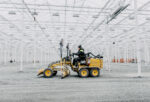Glossary
Keep up with the talk
To speed up the the transition to a circular economy we must all speak and understand a common language. This glossary will help you decode the most common terms, abbreviations, and frameworks relevant for this space.
Glossary
3R
The three R's in our name refer to Responsible, Renewable and Recyclable. Using these key principles we created WA3RM. By flipping the perspective on industrial waste, such as CO2, surplus heat and sludge as a costly problem, we found the key to a new business model where waste becomes a valuable resource.
Article 9 fund
An Article 9 fund under the EU's Sustainable Finance Disclosure Regulation (SFDR) is defined as follows: It has sustainable investment as its primary objective. This means the fund must have a clear goal of generating a positive sustainable impact, adhering to specific environmental or social objectives.
Aquaponics
A sustainable food production system that combines aquaculture (raising fish) with hydroponics (growing plants without soil), where fish waste is used as nutrients for plant growth.
Biodiversity
The variety of life in all its forms, including different species, ecosystems, and genetic diversity. Biodiversity plays a crucial role in maintaining ecosystem services, which are essential for sustainable production systems and the resilience of natural resources.
Carbon footprint
Carbon Footprint normally refers to a calculated value of the total amount of greenhouse gases that is associated with an activity, product, company, person, or country. Commonly reported in one of two units: CO2 emissions or CO2-equivalent emissions
Circular Economy
An economic model focused on designing out waste and pollution, keeping products and materials in use, and regenerating natural systems. It contrasts with the traditional linear economy (take, make, dispose).
EU CSRD
EU Corporate Sustainability Reporting Directive. Starting in 2025, the European Union will require large and listed companies to disclose information on risks and opportunities related to their Environmental, Social, and Governance (ESG) practices, with a particular focus on the impact of their activities on people and the environment.
EU Sustainable Finance Disclosure Regulation (EU SFDR)
The SFDR is part of the EU’s Financing Sustainable Growth Action Plan, aimed at shifting capital flows towards sustainable finance. SFDR requires asset managers and financial market participants to provide transparency on sustainability and imposes mandatory ESG disclosure obligations.
EU taxonomy for sustainable activities
The EU taxonomy is a key element of the EU's sustainable finance framework and a vital tool for market transparency. It guides investments towards economic activities crucial for the transition, aligning with the European Green Deal objectives. This classification system sets criteria for activities that support a net-zero pathway by 2050 and broader environmental goals beyond climate.
Food miles
The distance food travels from its point of production to the consumer. Reducing food miles is seen as a way to lower the carbon footprint of food.
Food security
Ensuring that all people have access to sufficient, safe, and nutritious food that meets their dietary needs for a healthy life, while maintaining sustainable agricultural practices.
Greenhouse Gas Emissions (GHG)
Gas emissions which contribute to the greenhouse effect. The Kyoto Protocol covers a basket of six greenhouse gases (GHGs) produced by human activities: carbon dioxide, methane, nitrous oxide, hydrofluorocarbons, perfluorocarbons and sulphur hexafluoride. GHG emissions are measured in carbon dioxide equivalents (CO2-e).
Hydroponics
A method of growing plants without soil by using nutrient-rich water. It allows for highly efficient water use and can be integrated into circular food systems.
Industrial Symbiosis
The process where waste or by-products of one industry are used as raw materials or inputs by another industry, creating mutual benefits and reducing environmental impact.
Life Cycle Assessment
A systematic method to evaluate the environmental impact of a product throughout its life cycle, from raw material extraction through production, use, and disposal.
P2X
Power-to-X (P2X) refers to technologies and processes that convert renewable electricity into various energy carriers or products, such as hydrogen. P2X technologies are seen as crucial for achieving climate neutrality goals and enabling a more flexible, sustainable energy system
Regenerative Production
Regenerative production provides food and materials in ways that support positive outcomes for nature, which include but are not limited to: healthy and stable soils, improved local biodiversity, improved air and water quality.
Self-Sufficiency
The ability of a community, region, or country to meet its own needs, particularly in terms of resources like energy, food, and materials, without relying heavily on external sources. In the context of sustainability, self-sufficiency promotes local production and consumption, reducing dependency on imports and minimizing environmental impact by shortening supply chains and lowering carbon emissions.
Shared Value
A business concept that promotes creating economic value in a way that also creates value for society by addressing its needs and challenges, especially in the context of sustainability.
UN Sustainable Development Goals (SDG's)
A set of 17 global goals set by the United Nations to address issues like poverty, inequality, and environmental sustainability, many of which align with circular economy objectives.
Waste stream
The flow of waste materials generated by industrial processes, which can be analyzed for potential reuse, recycling, or recovery.
Missing a term?

A development model made for industrial-scale impact
Development strategy
WA3RM identifies businesses that could run on industrial waste streams and matches these with industrial sites.
WA3RM develops project concepts with physical modelling underlying the business model, enabling focus on maximizing productivity and thereby impact
The industrial symbiosis that WA3RM’s process creates, adds a layer of complexity to projects that WA3RM manages, thereby
offering a one-stop-shop to anchor industries, tenants and finance.

